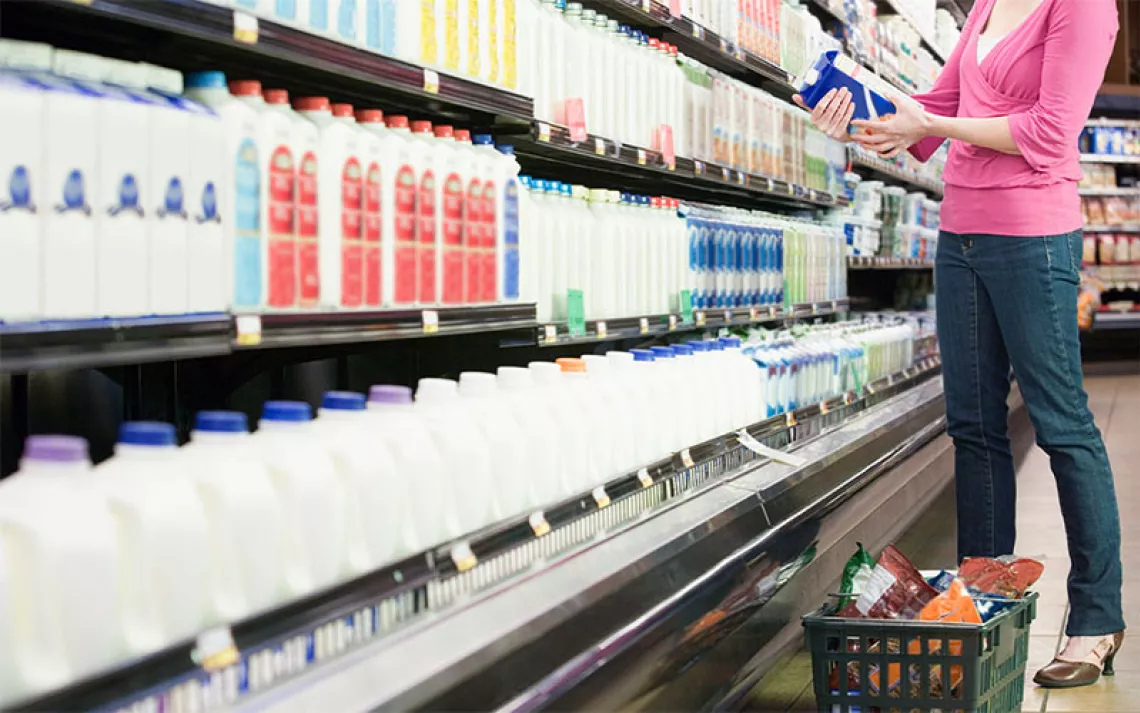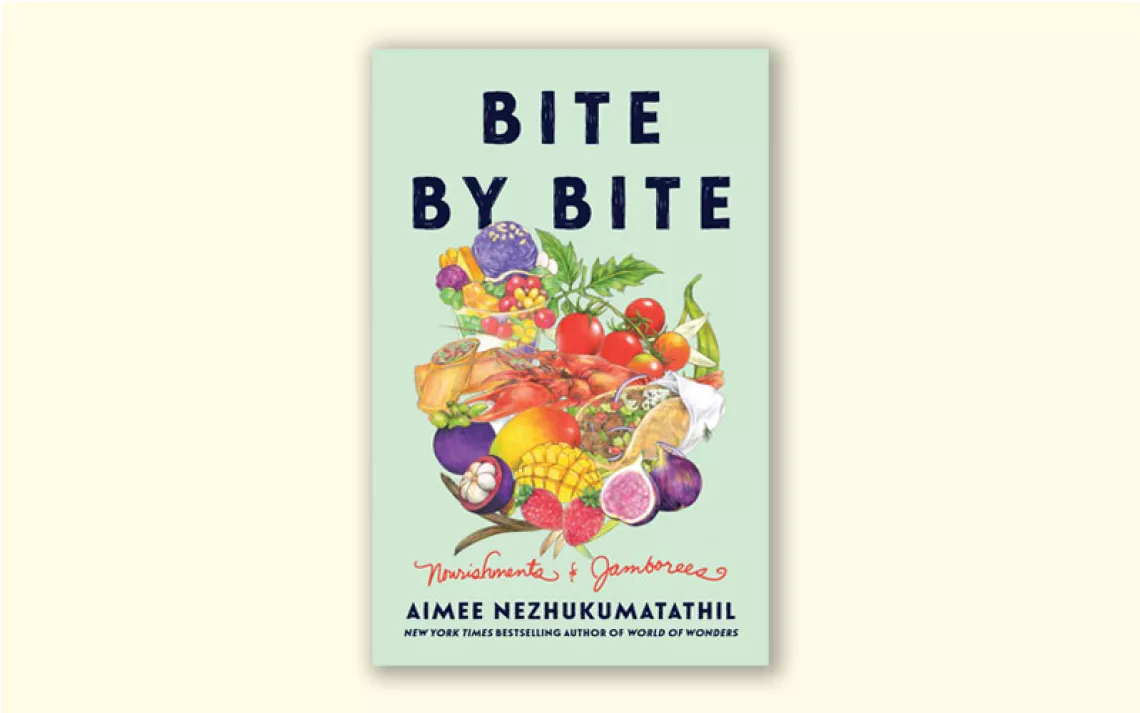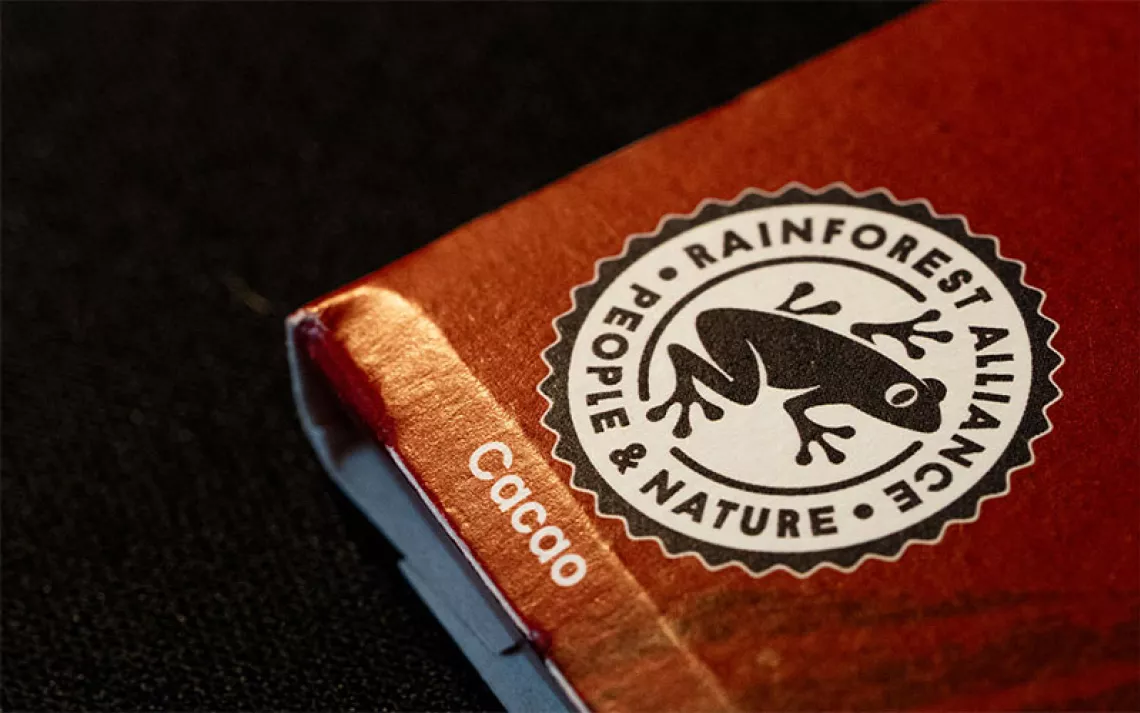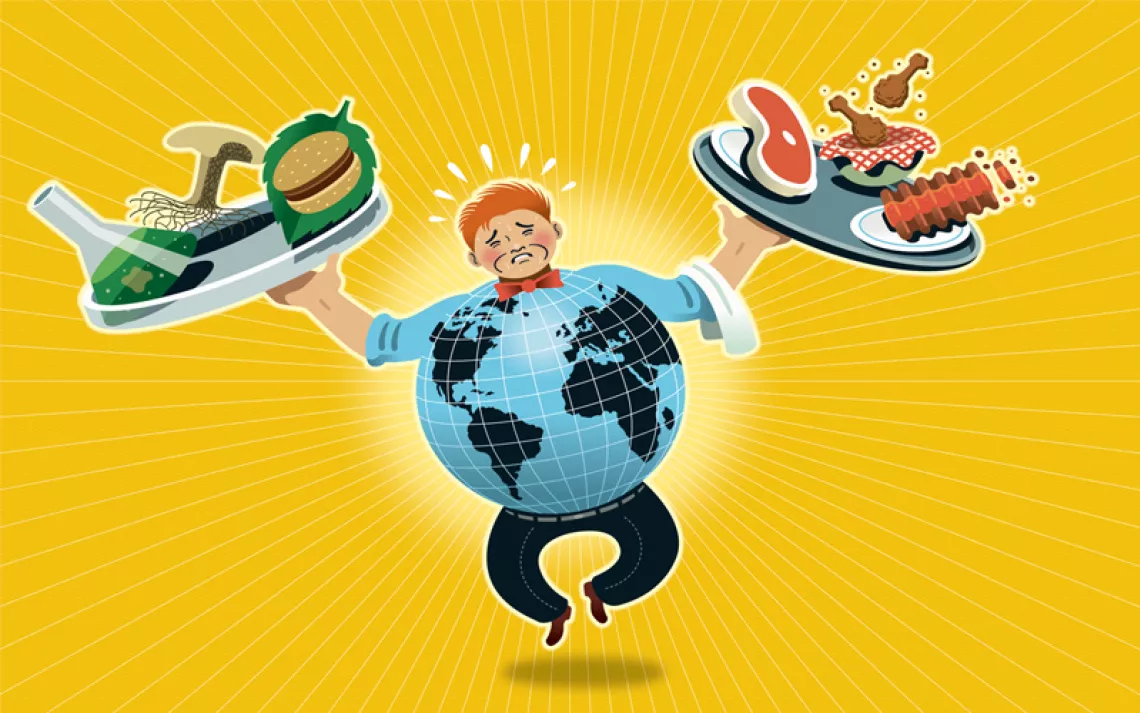The Future of Food Is Algae (Again)
A new generation of futurists look to the promise of pond scum
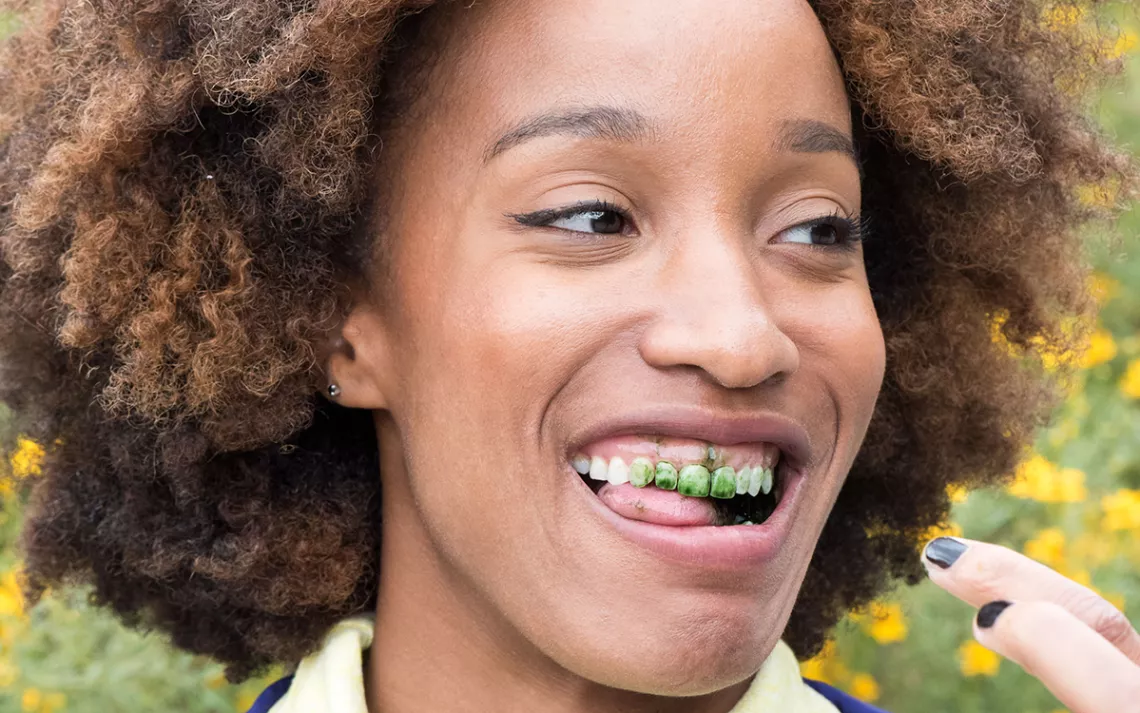
Nonfood has utopian ideals, and an algae-pride marketing aesthetic. | Photograph courtesy of Nonfood
A little over a year ago, CNN aired a segment about the future of food. “In 1800, there were a billion people on Earth,” said technology correspondent Rachel Crane. “Today, there’s seven times that. And by 2100, estimates say there could be nearly 12 billion people around the world.” Crane’s quest, then, was to taste-test food for a future with more people and fewer resources—one that would require eating lower on the food chain.
First, Crane confronted a platter of sushi made with a tomato-based raw tuna substitute and devoured it approvingly. Then, she opened a silver pouch containing an algae-based food bar made by a Los Angeles start-up named Nonfood.
“Ugh, it smells,” Crane said, recoiling. “Instead of trying to emulate flavors we know and love, they decided to embrace the algae.” She took a bite and gagged. Her teeth were stained slightly green, and her tongue, when she stuck it out, was covered in a dark green paste.
Oddly enough, this was good publicity. After the episode aired, Nonfood, which seems sometimes like a business and sometimes more like an art project, was flooded with orders.
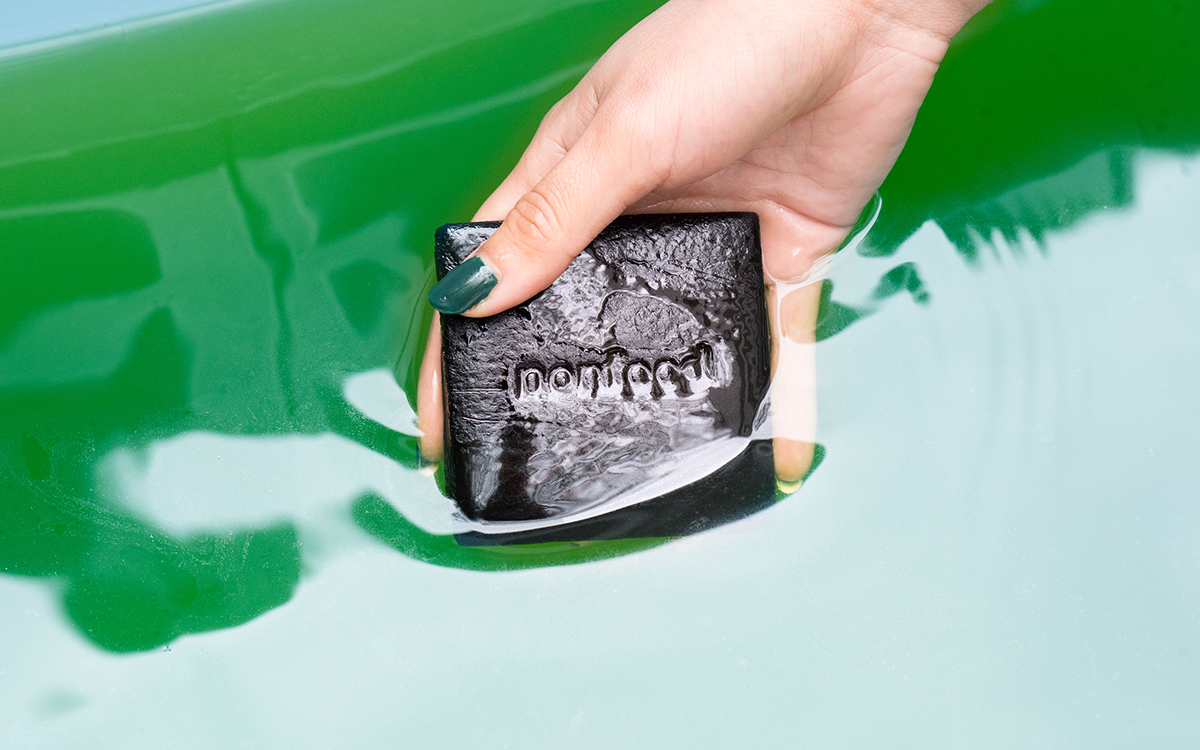
Algae is having a moment. When the Senate passed the latest farm bill last year, algae was upgraded from a food supplement to a crop and granted a suite of supports aimed at developing and promoting its use as an agricultural product—from crop insurance for algae farmers to the establishment of a new USDA Algae Agriculture Research Program to address challenges in farm-scale algae production. “We now sit at the beginning of a new chapter for the algae industry,” wrote Rebecca White, a microbiologist and VP of operations at iWi, an algae supplement company, on AltEnergyStocks, a news site for alternative energy investors. “We have the opportunity to elevate algae from a niche research project to a mainstream crop.”
Algae has had its moments before, though—moments that always seem to coincide with fears of ecological crisis. In the aftermath of World War II, agriculture as it existed was thought to be no match for the impending boom in human mouths to feed. Books like The Road to Survival by William Vogt and Our Plundered Planet by Fairfield Osborn (both published in 1948), became touchstones for a cultural moment marked by fear of overpopulation and an imminent crisis of Earth’s capacity.
At the time, half the world’s population was underfed, and the global population was projected to double from 2.5 billion to 5 billion by the year 2000. Land was finite and soil was being mismanaged and depleted. Meat was a waste of plants, and even plants were wasting energy. Staple crops such as corn and wheat only photosynthesized 1 percent of the energy they absorbed into food that humans could eat.
Various species of algae had been used as fertilizers and food sources for centuries (in classical Chinese, the same character is used for “algae” and “literary talent”). But in America, algae was new and futuristic, an appealing solution for a self-consciously modernizing nation.
A study conducted at the Stanford Research Institute in 1950 boasted that chlorella algae converted 20 percent of the sun’s rays into food. In 1953, Arthur D. Little Inc. in Cambridge created an experimental rooftop algae farm, and extrapolated from his success to claim that anywhere between 17,000 and 40,000 pounds of protein could be gathered from a one-acre algae farm, as opposed to 250 to 800 pounds from an acre of soy. An algae farm the size of Rhode Island, Little estimated, could provide half the world’s protein.
Chlorella didn’t scale up the way Little hoped. But in the 1960s, it was joined by a new contender in the race to feed the world with algae. Spirulina, a blue-green algae discovered in the Saharan Lake Chad and Mexico’s Lake Texcoco, lacked the hard cell wall of chlorella, making it easier to process into a form that could be digested by humans. In the following years, a Cold War “algae race” with the Soviets channeled funding into research about using algae as an “aerospace life support” system that would have converted astronaut waste into clean air, water, and food.
But by then American agriculture had become more productive than anticipated. Ammonia, first manufactured at scale for explosives during World War II, made it possible to produce synthetic fertilizer. Antibiotics enabled a boom in CAFOs—confined feeding operations that allowed animals to be raised under circumstances that would have led to epidemics of disease and infection in an earlier era. High-yield, hybrid varieties of cereal grains were developed and harvested with increasingly advanced farming machinery.
Research funding occasionally reappeared for algae-based biofuel projects when the price of oil was high, but algae production remained too expensive to compete with other ways of growing food. Tastes changed too, steering away from the functionalist food aesthetics of the 1950s toward the organic and local food movements of the late '60s and beyond. Chlorella and spirulina were relegated to the shelves of health food stores.
_____________
But in recent years, as the changing climate brought environmental anxieties back into the popular imagination, algae began to captivate a new generation of food wonks.
In 2013, Sean Raspet, one of Nonfood’s founders, was an art student getting an MFA at the University of California, Los Angeles. He gained access to a gas chromatograph on campus, using it to analyze perfumes and artificial flavors, breaking them down to their molecular components. He wondered if the experiences of taste and smell could be thought of as encounters with tiny sculptures and began making flavor molecules, displaying the results as aromatic gallery installations. In one, Aldehyde Gradient (2014), Raspet created five aldehyde molecules (aldehyde is commonly used to add scents to food and detergents), each with one more carbon atom than the last.
While Raspet was making art, Rob Rhinehart, a software engineer working long hours at a struggling cellphone-tower start-up, was tired of living off of corn dogs, frozen quesadillas, and vitamin C tablets. Rhinehart trawled government websites for information about nutritional science, compiled a list of 35 nutrients essential for survival, ordered the ingredients in powder and pill form online, and blended them together. After subsisting off of the drink for a month, he published the recipe for his invention on his blog, in a post titled “How I Stopped Eating Food.”
The post went viral, and Rhinehart started his own company—Rosa Labs—to manufacture the mixture and sell it under the name “Soylent.” The ground Soylent broke was not entirely new—similar meal replacement drinks already existed for people trying to lose weight (SlimFast), gain weight (Ensure), or build muscle (Muscle Milk). But Soylent was unusual in how it positioned itself as a challenge to food itself. “Food is the fossil fuel of human energy,” wrote Rhinehart. “It is an enormous market full of waste, regulation, and biased allocation with serious geo-political implications.”
In 2015, Raspet began developing flavors for Soylent. To Raspet, working for Soylent was a logical extension of his art—he was interested in sustainability and food, and thought that industrial agriculture, GMO crops, and processed food were unfairly maligned. “The ‘back to nature’ or ‘all natural’ idea of food can often have the counterintuitive effect of being worse for the environment,” Raspet told an interviewer. “Genetically modified, industrially farmed crops can potentially have a drastically lower environmental impact in terms of the amount of land, water, and petroleum [to power farm equipment, irrigation pumps, etc.] used.”
Soylent’s greatest asset—that it replaced the complexity of food with pure functionality—was also a drawback. Even fans got bored with the flavor, which some described as tasting like pancake batter. Raspet mixed Soylent with acrid, chemical flavors and sold them in editions of two as Technical Milk and Technical Food. He handed out Soylent samples at the Frieze art fair in New York. His first official flavor was Nectar, based on a chemical compound that honeybees use to mark the entrance to their hive. The flavor was polarizing: It was described as tasting like Fruity Pebbles milk, generic lemon cake from Safeway, a public restroom urinal cake, Lemon Pledge, and rosewater. Nectar was discontinued six months later.
But then in the summer of 2016, Raspet left Soylent and turned his attention to algae. The decision was the culmination of a slow burn. When many think of carbon emissions and climate change, they think of cars idling in traffic and fuel-guzzling airplanes. But the Consultative Group on International Agricultural Research (CGIAR), a partnership of 15 research centers around the world, estimates that the food system “from fertilizer manufacture to food storage and packaging,” is responsible for a third of the global carbon emissions caused by humans. The real problem that needed to be solved wasn’t flavor—it was food itself.
Back in 2014, before working at Soylent, Raspet had read an article by an environmental writer named John Upton about how algae produced unparalleled quantities of protein for the negligible amount of land and sunlight it required. Rosa Labs had begun selling food bars with algal flour the summer that Raspet left. Things hadn’t gone well: Some customers began experiencing violent vomiting and diarrhea, and Soylent blamed its algae supplier, a company called TerraVia. (TerraVia denies the allegations.)
Soylent’s struggles with algae didn’t faze Raspet, who saw potential for a paradigm shift. If he could get more people eating algae, people would start talking about eating algae; people would eat even more algae; microalgae farms would proliferate in unused urban spaces, solving the dual issues of unsustainable food production and transportation; and the planet could, maybe, live happily ever after.
Raspet and his partner, artist and writer Lucy Chinen, began scouting algae suppliers. Together with Dennis Oliver Schroer, a Berlin-based brand consultant, they submitted an application for a start-up grant from Singularity University, a Silicon Valley tech incubator. Singularity University turned them down, but lead them to Mariliis Holm, an Estonian food scientist with experience in algae. The four brought their project to Food-X, a New York City–based accelerator for start-ups related to food. It was there, surrounded by other nascent food futurists, that they hashed out the details of their vision.
They decided to name their company Nonfood. Chinen and Raspet had envisioned a line of algae products that ran the gamut from breakfast cereal to meat substitutes, but as they began working through the minutiae of product development they realized how much work it would take to bring even one product to market. The group decided that their first product would be the Nonbar, a protein bar made out of a combination of algae types (chlorella and spirulina, along with lemna, an aquatic plant often referred to as duckweed), bound together by tapioca fiber and sunflower oil. The Nonbars would be made in short runs as orders rolled in. As the number of orders grew, Nonfood would be able to purchase the ingredients in greater quantities, and economies of scale would bring down the cost.
Like Soylent before it, the Nonbar was marketed less as food and more as a provocation. The bar was ashen and square, with “Nonfood” stamped into its rough texture. The company’s website looked more like the landing page for an art gallery than for a food company. “Cultures define themselves by what foods they eat and what foods they don’t. Culture evolves. Nonfoods become foods,” read one section.
_____________
Nonfood is only sold online, but Raspet thinks the bars will make their way into a brick-and-mortar retail space and possibly corporate cafeterias within the next six months. So far, orders have come mostly from the Bay Area, New York City, and Los Angeles. A few mysterious requests came from Alaska.
Nonfood doesn’t produce its own algae. Instead, it buys from large industrial algae farms, which tend to grow algae in places where land is cheap and sunlight is plentiful. Many of the farms sprung up in the early 2010s, after an uptick in oil prices sparked a renewed interest in algae as a source of biofuel. As oil prices fell in 2014, some of these companies diversified by cultivating algae for health supplements.
But Raspet’s dream of small-scale algae farming lives on in his art. In September, Nonfood plans to launch a two-month installation in a horticultural park’s greenhouse in far northern Los Angeles County. A series of clear tubes suspended in the greenhouse will grow a few different types of edible algae—chlorella, spirulina, nannochloropsis, and maybe even chlamydomonas reinhardtii (Raspet refers to the latter as “C. reinhardtii,” on the grounds that “chlamydomonas” is not an appealing name for food source).
The purpose of the installation is part outreach, part R&D; Raspet wants to see if a more distributed type of algae production is possible. If things go well, Raspet plans to do a similar project in Detroit, where he and Chinen own a home and where an urban farming scene is well established. “There’s a lot of land in Detroit that’s not being used,” he told me.
If all food production could collapse into small-scale algae farms scattered throughout population centers, says Raspet, all the land used for conventional agriculture could be converted back to wilderness. Algae uses about 1 percent of the land of other food crops, he added, affording “a real possibility of realizing E.O. Wilson’s ‘half Earth’ idea,” which claims that our best hope for protecting the ecology of our planet is to set aside half of its surface as a bioreserve devoid of human presence.
He also hopes that the greenhouse installation will inspire visitors and the residents of the nearby neighborhood and lead to his ultimate vision, of cities filled with town-square-like algae farms. “People could meet there, maybe see their neighbors when they’re getting food,” Raspet told me. “I’ve heard the park has a lot of weddings,” he added, hopefully. A picture of the bioreactor behind a bride could make good publicity.
_____________
At present, the Nonbar claims to be the only consumer packaged good that derives its nutritional content almost entirely from algae (the algae provides the protein; other ingredients like sunflower oil, fava beans, mixed tocopherols, and prebiotic tapioca fiber provide flavor and texture and a few additional vitamins and nutrients). To prevent copycats, Raspet prefers not to reveal where exactly Nonfood sources its algae and other ingredients.
Nonfood has already attracted the attention of would-be competitors. Anastasia Davydova Lewis, 24, first heard about Nonfood from a fellow intern at DIS.art, a contemporary art publication in New York. She was at first confused, then attracted. “That’s cool; that makes sense,” she recalls thinking. She had liked the idea of Soylent since she first saw a billboard with the slogan “Pro-GMO.” It felt like an assertive solution, in contrast to the art world, which she was coming to see as cloistered. “These people are moving towards something. They’re not afraid!”
There was one hitch. “Nonfood is disgusting,” Davydova Lewis says, warmly. She has boxes of their earlier bar lying around her apartment and in her freezer but never eats them. (Raspet notes that the current version of the bar is much more conventionally appealing—the strong algae flavor has been supplemented by a sweet, date-like taste with hints of matcha.)
Davydova Lewis is laying the groundwork for the launch of her own startup: algae-based gummy bears that she plans to sell under the name Nootreats (a reference to nootropics, a term for drugs or supplements that claim to enhance cognitive function in healthy individuals).
“Our vision for Nootreats is to have every product comprised of only algae and herbs grown on our own hydroponic farm, the most water-efficient form of agriculture ever invented,” boasts the Nootreats beta website. “Additionally, we dream of opening our own GMO lab to engineer zero-glycemic-index sugar, mushrooms, and protein-rich algae with a familiar flavor profile. Maybe even plants that can flourish on the moon,” the copy continues.
In late April, when I met Davydova Lewis, she was carrying a bright-yellow napsack emblazoned with a NASA logo (“Don’t you think it’s interesting that people of our generation are interested in space? And farming. I think it’s part of a kind of prepper mentality, fear of apocalypse,” she said).
As we walked along Lake Merritt, the brackish body of water nestled in Oakland’s center, she rummaged through her bag and pulled out a copy of City of Quartz (“Have you read this?”); sunscreen and a mirror (“I’m really into treating young bodies like they’re already old.”); a Harvard Business Review book called On Strategy; and two bottles of turmeric supplements.
As we followed the lakefront path, I could see aquatic plant life peeking through the murky water. The lake had once been notorious for odorous algae blooms but was now reconnected to San Francisco Bay and thriving. As the nation’s largest body of saltwater within city limits, could Lake Merritt host some massive algae farm sometime in the future?
Davydova Lewis spoke in wild theoretical leaps and self-referential punchlines. She walked into a Whole Foods grocery store by the lake and bolted down the energy bar aisle, picking up packages and grimacing at the ingredients. She expressed skepticism about the possibility of doing good through selling food, citing “ecofriendly” companies that include excess amounts of sugar, health food fads like quinoa that end up making those foods unaffordable to people who grow them in the first place, and organic foods that come packaged in unrecyclable plastics.
On our way out, she stopped at the salad bar, covering her meal in powdered turmeric at the end. As we sat outside, she offered me a bite; it was disgusting. I imagined—and hoped—that Nootreats would taste better. She assured me that it would. “I’m not a capitalist,” she said, “but I’m down with making a company and seeing how far I can take it until it turns into something bad, and then kill it, and then start again.”
_____________
When I finally received a white flat-rate box in the mail containing seven bars of Nonfood wrapped in silver plastic, I was excited. It had been over six months since I’d started to learn about algae as food, and anticipation had been building. Over the course of all my long conversations with Davydova Lewis and Raspet, some not insignificant part of me had been wooed by their vision. They didn’t seem like profiteers, or naive techno-utopians, or impractical artists. Feeding the world with algae seemed goofy, sure, but it was also a serious idea, borne of real ideals and a real need. The food system as it’s currently set up isn’t sustainable.
I was at my parents’ house in Seattle when I opened the package. My mother was baking a rhubarb pie and listened skeptically as I described to her Nonfood’s vision of the future: an algae farm in every town square, a world freed from the inefficient vagaries of food production, the ravenous water consumption and land use.
She didn’t bother to hide her disgust. This was not a world she would want to live in. Why not make ingredients out of algae—flour, maybe—so we could retain the human pleasures of cooking instead? What we really need, she told me, is good, locally grown food, available at plentiful grocery stores for people in need.
From the comfort of the sun-drenched kitchen in a wealthy city on the West Coast of the United States, her argument made sense. But it couldn’t undo what I already knew about poorer countries, food deserts, and a planet plagued by a shifting climate. Organic and farm-to-table food movements had been around for so long—and their rhetoric co-opted so voraciously—that I, like Nonfood, was ready for something new.
The bar was smaller than I expected when I removed it from its wrapper—only about 1.2 ounces. In this edition—prototype four—they had reduced the size slightly from 45 grams to 35 grams to bring the cost per unit down from $4 to $3. It barely covered the palm of my hand. I had imagined the food that would change the world with a little more heft.
But the most important test was yet to come: What would it taste like, this environmentally conscious ambrosia? This potential panacea for world hunger and global warming? This pond scum–cum–global savior?
I sank my teeth into the bar’s surface. It had an appealingly tacky texture that, I had been told, had been difficult to engineer. A few chunks of roasted fava beans added crunch amidst the black, Play-Doh-like mass. I was then met with a taste reminiscent of a salted, lightly spiced Fig Newton, before a saccharine sweetness overtook my palate, chased by a skunky, bitter aftertaste that lingered mercilessly.
As the concept gave way to reality, I felt deflated. It was clear this was still a work in progress. I might feel that if algae could save us, we should accept it in any form. However, even if I ate algae every day, not many people would be clamoring to join me.
But even if it wasn’t yet a meal, it was a provocation. Was a better world possible? As the aftertaste faded, I still felt a glimmer of hope.
 The Magazine of The Sierra Club
The Magazine of The Sierra Club
